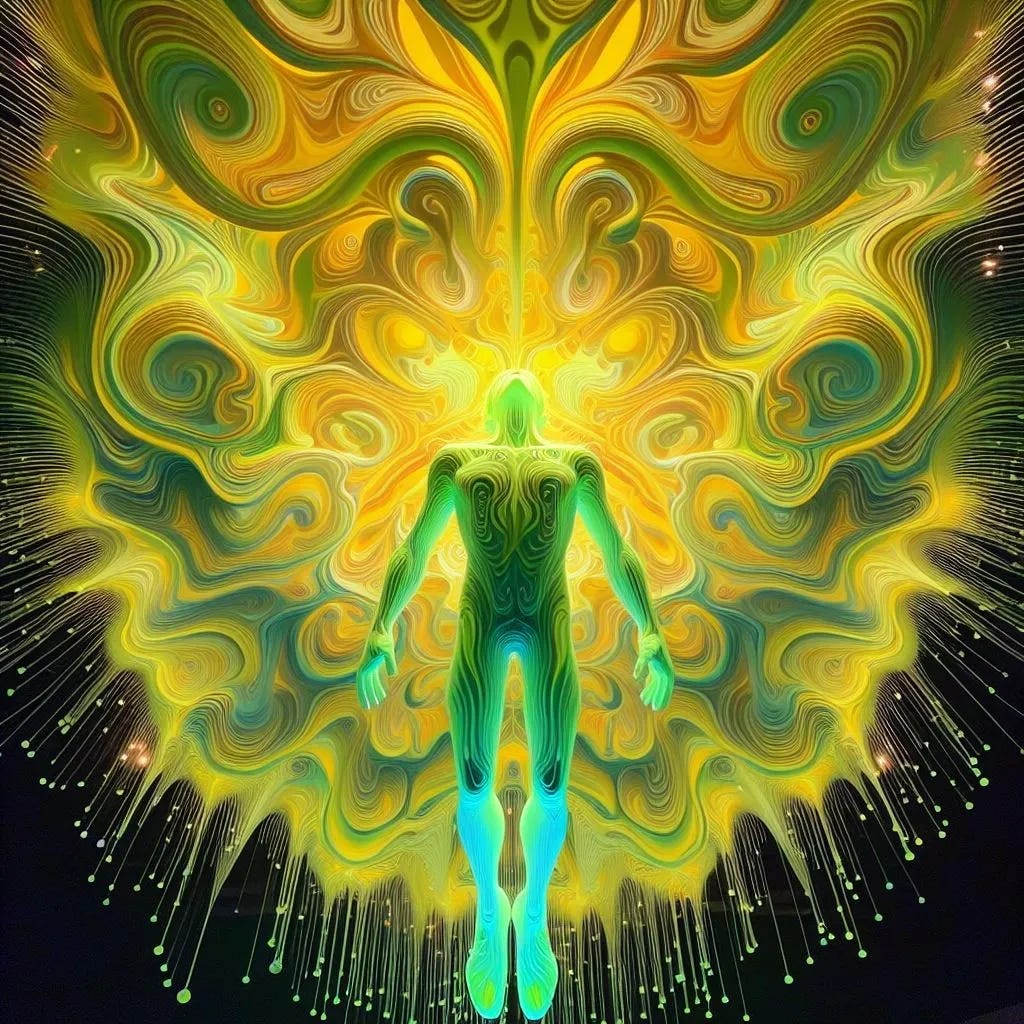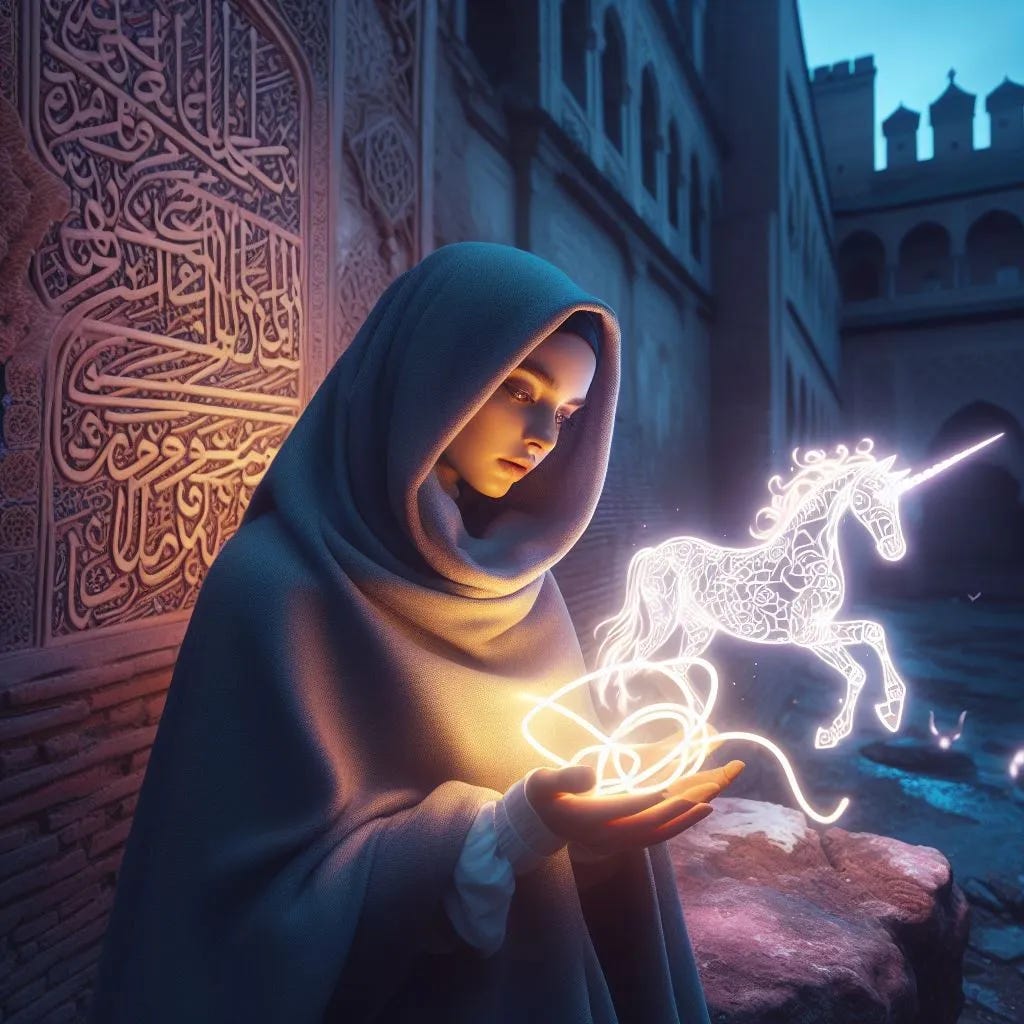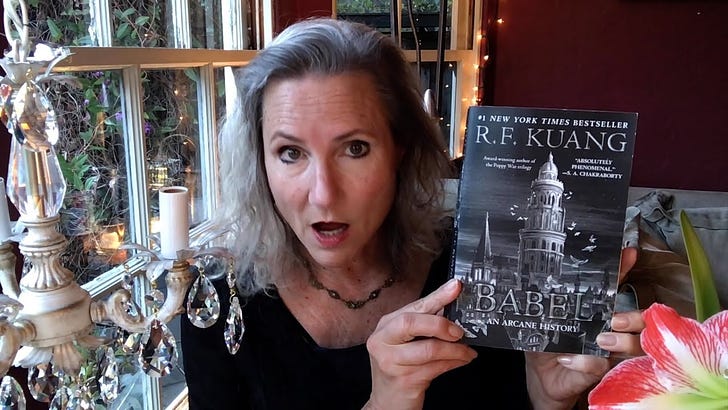Genesis & the Naked Deception
exposing gods of trickery
Deciphering the Bible and figuring out what it really is has become ongoing collaborative effort with much help from Kathleen, Rhonda and Nefahotep, and this post is no exception. But I’m also going to liven up the ‘stack with some AI images from Amy of What’s In a Name? If you’re watching the video, you’re not going to want to miss looking at the pictures, without which you’ll miss half the jokes.
Kathleen Devanney and I have been enjoying a multipost extended dialogue on the nature of reality and forgiveness. She quotes her mother as saying that, if you knew everything about what someone’s been through, you couldn’t withhold forgiveness. And since we’ll never know everything, why not skip right to forgiveness? And then she sent this astonishing reply:
I genuinely believe that even as we suss through so much confusion and pysops and various, obvious attacks on humans, somewhere and somehow—that we can still access—nothing happened. How can these two things be true at once? It must have something to do with our multidimensional selves and the role of time and space, maybe part of the game of hide and seek... But IDK.
This floored me because it speaks exactly to what I’ve been fumbling towards with socio-spirituality: taking a hard look at the reality IN the world while questioning the Reality OF the world. All history is, maybe, being written backwards. Perhaps love and forgiveness are the same: giving the benefit of the doubt that people’s actions make sense to them, and we would do no better in their shoes.
As we change the stories, a light shines on a different dimension. To paraphrase Peter Duke, all history is made up, some of it is true. We can bring a different history into focus, where we understand why people did things and might find out they did nothing. Forgive them for they … did nothing. That could be in a literal sense or metaphysical.
In this episode, I’m looking again at the Bible and Genesis. As I outlined to Kathleen, here are the options for what it is:
A divinely dictated, infallible account of God’s interactions with and actions on behalf of a succession of righteous patriarchs, chosen by God to rule the world.
The literal history of a family genealogy.
The divinely inspired mythos of the world’s creation, destruction, re-population, division into languages and race, and hierarchy of right to rule.
Neutral observers making sense of natural phenomenon and worldly events.
Neutral observers making sense of supernatural phenomenon and otherworldly beings.
Worldly rulers inventing a pseudo-mythos that they're descended from gods and otherworldly beings, destined to rule, with the same story repeated with different players again and again.
A coded playbook to control the visible rulers of the world from behind the scenes through secrecy within a small group and deception of religious followers.
An encrypted strategy of those whose superstition is that their power comes from human sacrifice and, to be a willing sacrifice, they have to warn us.
A dream psychoanalysis of our guilt, fear and blame. A projection of how a psychopathic mind works, per Rhonda.
A trail of puzzle clues left by Spirit to lead us where we need to go.
Many of these could be true at the same time. Kathleen feels there’s a parasitic interdimensional non-human energy form that requires a certain frequency to be receptive. All of the degradation of our physical and mental capacities, the toxicity of our food and environment, make us vulnerable. But it's not human or human nature, and can disappear in an instant when the frequency shifts.
In The Genesis of the Dysfunctional Family, I focused on #2 as generations of bitter, spiteful, competitive sons throwing their brothers, wives, daughters and entire races under the bus to justify their right to rule over them as slaves. I’ve looked at Genesis on a literal basis in The Blood of Eden and The Curse of Babel, which I’ll link below. In this episode, I’m going to focus on the second half of #5-10. It’s my hypothesis that these are all true.
Let’s recap Adam & Eve, version 2 where God has turned into LORD God. The garden is downriver from Eden where it separates into four headwaters: the Pishon that winds through Havilah where the gold is good and there are aromatic resins and onyx, the Gihon that goes through Cush, the Tigris along Asshur, and the Euphrates.
Is that pointing to infinity or gold in them thar hills?
The Man is created to work the garden.
My Bible lists Adam’s occupation as zoologist because he names all the animals while they’re looking for one to be a suitable helper to The Man.
After the LORD God gives up on repurposing the animals, since it’s too much trouble to make another human from scratch, he sedates The Man with anesthesia and performs surgery to take a rib to make The Woman. Nice rib, Adam.
But then the serpent, described as more crafty than the wild animals, uses his NLP techniques on The Woman asking, “Did God say you couldn’t eat from any of the trees?” She says, “Just the one in the middle. If we touch it, we die.”
The serpent, who seems to be on a first name basis with God—none of this LORD business—says “You won’t surely die. Like, not really for sure. You’ll be like God, seeing the good, bad and the ugly.” So she, having the temerity to want wisdom and knowledge, took a bite out of thinking for herself.
Then she gave The Man a piece of her mind.
Next thing you know, they’re naked! Quick, sew together some fig leaves with your needles and thread and gold, oh my! The LORD God finds them hiding. He demands, “Who told you that you were naked?” The Man says “That Woman you put here with me did it. It’s all her fault!” And he climbs right up into that tree of judgment.
The Woman says “The Serpent deceived me!” So the LORD God curses them all and then makes The Man and The Woman some nice skin suits so they’d have clothes.
So here’s where it gets interesting. The footnote says in Hebrew, the word for crafty and the word for naked are almost identical. And another word for crafty is deceiver. So maybe it’s not Adam and Eve but the LORD God the Emperor who’s wearing no clothes. When he demands, “Who told you that you were naked?” it might really be, “Who told you the truth?” And what or who does the serpent represent?
This sheds (pun intended) a different light. The serpent is a striptease apocalypse, removing the cover of deceit like a second skin. Remember, the heroes are really the villains and the villains are the heroes. The Woman is the first to see the LORD God is a lie, no god at all, just a pretender. The Man says, “But what about my nice suit?”
This little hint flips the tables on Naked Noah the deceiver. Is it Ham who speaks the truth or Canaan? When Shem and Jephath walk in backwards, they’re pretending they don’t see the lie. And they cover him with a seamless cloth, truth and lies interwoven.
Here is a fascinating video sent by Nefahotep called Bloodline of the Serpent Seed by Robert Sepehr. At 2:04 it explains the etymology of dragon to Greek drakon from drak- stem of derkesthai ‘to see clearly,’ source of Sanskrit darsata- ‘visible’, Old Irish adcondarc ‘I have seen,’ Old High German zoraht, ‘light, clear.’
The literal sense is ‘the one with the glance.’ The Bible substitutes dragon for Hebrew tannin ‘a great sea-monster’ and tan, a desert mammal now believed to be the jackal. Well that’s quite a horse of a different color! The significance of the jackal will come back around in the story of Abram, who I suspect was the mercenary warlord Abdi-Ashirta represented as a jackal in the Armarna Letters to the Pharaoh.
The video is 20 min. and extremely interesting. It talks about the Merovingian dynastic myth of the Royal Dragon Court. The name means mer- or sea and -vingi which is serpent or werewolf. Their documents assert that the new king would ‘rule but not govern’ or be the priestly power behind the throne, passing on divinity through the maternal line and intermarriage.
They included the Egyptian dynasty of Sobek, the crocodile-headed god sometimes pictured with a jackal’s body. The Egyptian bloodline contains the Davidic house of Judah who married into the Merovingian kings of the Franks. Because they practiced polygamy, they had many children and “married into almost all of the noble families of Europe during the 5th, 6th, and 7th centuries.”
Let’s go back to Genesis. Adam finally has sex with Eve, now that they know they’re naked, and she gives birth to Cain. All this time and I didn’t realize that Cain was the oldest and the rightful heir to Adam. Eve exclaims, “With the help of the LORD I have brought forth a man,” so maybe that paternity is in question. LORDs have first nuptial rights, I’ve read, and his curse for painful childbirth doesn’t sound like help to me.
Then she births Abel who the LORD looked on with favor. According to the omniscient narrator, Cain kills Abel and the LORD curses him to be a restless wanderer on the earth, which means going East to the land of Nod. There he and his wife have Enoch, and Cain builds him a city with his name. A small one, maybe a 5-minute one, since they’re the only family in existence.
Enoch has Irad, Irad has Mehujael, Mehujael has Methushael, Methushael has Lamech who is the first named polygamist marrying Adah and Zillah from A to Z. Adah has Jabal and Jubal, and Zillah has Tubal-Cain and a sister Naamah, the first named woman in six generations. But Lamech confesses he killed a young man for injuring him, and so his lineage is cursed. If Cain is cursed seven times, he states he’s cursed seven times seven, or one for each generation.
When she’s a great-great-great-great-great grandmother, Adam finally has sex with Eve again. She names the son Seth and says, “God has granted me another child in place of Abel, since Cain killed him.” Welcome to the world, fratricide baby!
After mentioning that Seth has Enosh, which sounds suspiciously like Enoch, they start Adam’s genealogy all over again with no mention of Cain or Abel. It skips right past the previous family history like it never happened, just like the creation story did. At 130 years old, Adam has ‘a son in his own likeness, in his own image.’ Those are some god-words, for sure.
Fortunately, since there’s still a city around to bear witness, Seth starts with Enosh. He then has a bunch of generations with overlapping names of Cain’s lineage, culminating in Lamech. But this Lamech has left his curse with Jabal-Jubal-Tubal-Cain, and instead his heir is Noah, the only righteous man on earth. I’ll be looking at the geopolitical comparison in the next Biblical episode.
But when I looked up Seth, I found it’s also the name of a god who infiltrates Egypt in the third millennium BCE. He’s also known as Set. From Brittanica:
Originally Seth was a sky god, lord of the desert, master of storms, disorder, and warfare—in general, a trickster. Seth embodied the necessary and creative element of violence and disorder within the ordered world. The vicissitudes of his cult reflect the ambivalent attitude of the Egyptians toward him, as well as the shifting political fortunes of Egypt.
During the 2nd dynasty (c. 2775–c. 2650 BCE), King Peribsen identified himself with Seth for the first time, giving himself a Seth title instead of the traditional Horus name. His successor, Khasekhemwy, gave both Horus and Seth equal prominence in his titulary, reflecting the mythical resolution of the two gods. During the rule of the Hyksos invaders (c. 1630–1521 BCE), Seth was worshipped at their capital, Avaris, in the northeastern Nile River delta, and was identified with the Canaanite storm god Baal.
During the New Kingdom (1539–c. 1075 BCE), Seth was esteemed as a martial god who could sow discord among Egypt’s enemies. The Ramesside pharaohs (1292–c. 1075 BCE), originating in the northeastern delta, ranked him among the great gods of Egypt, used his name in their personal names (Seti I and Seti II, Setnakht), and promoted the image of Seth as the protector of Re in the prow of his bark, slaying Re’s enemy, Apopis. Seth also joined Amon, Re, and Ptah as the fourth of the principal gods of the cosmos.
According to legend, Seth would take the sun god Re across the sky in the day and then kill Apopis, the great serpent, every night in the underworld. Is it significant that he’s worshipped at a city called Avarice? And has stolen the identity of the Canaanite god Baal? Perhaps those double-a’s are a tell for why Lamech’s daughter Naamah is named as one of those cursed Canaanite women.
Set is depicted as a canine similar to a jackal but also took the form of a bull or crocodile or man with the head of a donkey. In the mythology of Seth, he kills and dismembers his brother Osiris, who is re-membered and resurrected by his sister-wife Isis long enough to conceive Horus, the god embodied by the Pharaoh. In some versions Horus is Seth’s nephew and in others, his brother. The reference continues:
During the Old Kingdom of Egypt, Horus and Set were generally viewed as twin supporters and defenders of the god Ra, head of the Egyptian pantheon; and they were often depicted anointing the king, as the divine source of his authority. The association of Horus and Set probably reflected the reconciliation of a struggle between two royal cults. …
Although Set was originally viewed as the son and defender of Ra and the Egyptian kings, his reputation among the people declined along with the rise of the cult of Osiris. Originally a vegetation-god, Osiris became one of the pre‑eminent gods of the Egyptian pantheon. Worship in the Osiris cult stressed the role of Set as violence personified; the murderer of his brother and usurper of his throne who, instead of standing alongside Horus, became his eternal enemy. This view of Set was encouraged during the Second Intermediate Period, when Egypt was invaded by the Hyksos from Western Asia. …
During the Third Intermediate Period, Set was deeply unpopular: his worship was abandoned, and many depictions of him were destroyed or defaced.
Is Adam Osiris, who is killed and dismembered but re-membered by Eve-Isis long enough to conceive Seth-Horus? Do these parallel mythologies merge the warlord dynasty of Avarice with the Pharaohs, giving the latter a ‘divine’ charter to rule along with armed enforcement of tax or grain collection?
Set is the brother to Osiris, as Seth is brother to Cain. Noah goes back seven generations to invent a murder and claim the inheritance for his newly invented ancestor Seth. The story of Noah is the seminal one that rewrites the genealogy to justify his son Shem, father of the Shemites, as the legitimate heir of the one born in the image and likeness of the god.
When did all this happen? Biblical Seth is dated in the Julian calendar as born in 3874 BCE and dying in 3670. This would correspond with the earliest appearance of the Set animal in 3790 BCE. The Hebrew Masoretic text dates the beginning of the world as 3760 BCE. The infiltration of the Set dynasty into Egypt with King Seth-Peribsen is in the second dynasty that starts in 2890 BCE.
Wikipedia on Seth confirms:
In the Osiris myth, the most important Egyptian myth, Set is portrayed as the usurper who murdered and mutilated his own brother, Osiris. Osiris's sister-wife, Isis, reassembled his corpse and resurrected her dead brother-husband with the help of the goddess Nephthys. The resurrection lasted long enough to conceive his son and heir, Horus. Horus sought revenge upon Set and many of the ancient Egyptian myths describe their conflicts …
In a key episode in the conflict, Set sexually abuses Horus. Set's violation is partly meant to degrade his rival, but it also involves homosexual desire, in keeping with one of Set's major characteristics, his forceful, potent, and indiscriminate sexuality. In the earliest account of this episode, in a fragmentary Middle Kingdom papyrus, the sexual encounter begins when Set asks to have sex with Horus, who agrees on the condition that Set will give Horus some of his strength.
More echoes of Noah and Canaan. One narrative recounts how Isis obtained a magical substance from Re’s senile dribbling and fashioned from it a snake that bit him; to make her still the agony of the snakebite, he finally revealed to her the secret of his “true” name. Is that was Eve got from the Tree of Knowledge? What is Set’s true name?
And just when you think things can’t get weirder, the Wikipedia entry writes that Set:
… had relationships with the foreign goddesses Anat and Astarte. From these relationships is said to be born a crocodile deity called Maga.
For those who believe no words are accidental, check out this temple coin from Diva Drops commemorating the Cyrus-Balfour-Trump Declaration 1917-2017. More on that later when we’ve all had more time to digest this poisoned feast.
Does a psychoanalysis of the patriarchs of Genesis from the view of the slave-wives, raped daughters and disinherited sons. Second in the series of Revolutionary Mystics, it springs from the gnostic gospel of Philip to A Course in Miracles to the Bhagavad Gita to the Tao. Quotes Christopher Frye in A Sleep of Prisoners.
In correlation with the Peter Gabriel song, I start with the social and move into the metaphysical. Then the Biblical to the archetypal and personal. And I end with why I feel something has gone terribly wrong with the relationships between women and men, and how the I Ching may hint that the spiritual, social and sexual all lead to the same solution.
Puts the Biblical story of Babel in context of the genealogy of Noah, transferring the right to rule the world from Shem (Shemites) to Abram, the first Hebrew. Explains the thorny problem of how there are so many languages if everyone descended from Noah. Also looks at R.F. Kuang's excellent book Babel on translation, etymology and colonization.

































I loved how you connected everything here, Tereza.
About Osiris or "Ausir" quotes from the post:
"Although Set was originally viewed as the son and defender of Ra and the Egyptian kings, his reputation among the people declined along with the rise of the cult of Osiris. Originally a vegetation-god, Osiris became one of the pre‑eminent gods of the Egyptian pantheon. Worship in the Osiris cult stressed the role of Set as violence personified; the murderer of his brother and usurper of his throne who, instead of standing alongside Horus, became his eternal enemy."
"Osiris" (Ausir) is attributed to a real living person who ruled in one of the Madi Kingdoms of lower Egypt in pre dynastic times. His name at that time was "Andjetyi," his wife's name was "Ata3t." Their remains were recovered from Mastaba 17; this was during WW2 and the place where these remains were kept, got bombed.
Andjetyi was into agricultural and farming organization for his people. Because of the great accomplishment of draining the fields and improving the arability of the soil for crops, he became known and loved as a god of agriculture in later times.
Excerpt from "Ancient Egypt Online." https://ancientegyptonline.co.uk/andjety/
"Andjety (Anezti, Anedjti) simply means “he who is of Andjet” – the place of the djed (Busiris in the ninth nome of Lower Egypt). It is thought that he was a historical ruler of the ancient Egyptian city of Djedu (Busiris) who became the god of domestic and farm animals, and probably introduced the use of the shepherds crook as an emblem of kingship (an interesting precursor to the Christian notion; “the lord is my shepherd”)." ----- Notice the similarity of "Busiris" to Osiris.
Here is a great video from Ancient Architects, has a lot of interesting points to make:
https://www.youtube.com/watch?v=P3N_C8BaqG8
It's quite true that there seems to be quite a few connections between OT biblical accounts and Egyptian Myths; as you have beautifully described, there are variations to the stories of the Egyptian Myths, depending on when they were written and by whom. There were multiple cultures and I'm sure that the language spoken by these cultures came together as well as the stories they told were melded together in some ways.
I admire your ability to look into so many details and connect so many dots. As you know I tend to deal in broader strokes, so truly appreciate the level of nuance you can engage.
I think safe to say, the OT is not about a loving God! That they were able to maintain such a story as cover for a God we should fear (yeah, a pretty vindictive guy) and obey is remarkable.
In addition to links I've shared on those folks who've been looking at the story as an account on other beings coming to earth and taking over, I'm including a video (Not good quality) of a talk given by Jordan Maxwell who was friends with Sitchin. He basically agrees there was an 'alien' presence and considered themselves god-like, and who genetically modified humans.
He thinks the Reptilians played a role (says, he was the one who explained this to Icke in the early 90's) and that this presence still exists on the planet today.
He thinks we need to throw off all governments, all bodies who assume they are better than (the royals) and all religions as these are the mechanisms of control. Details aside I agree our story of humans on earth includes non-human beings and a lot of manipulation. But as I noted in earlier exchanges the continued presence shows up interdimensionally, mainly, and has to do with a parasitical like take over of human thought.
I do think our genetics have been played with and we have then been hybridized. 'Their' obsession with genetics is obvious and ongoing. I don't think it's as big a deal as many might, since we are a lot more than our DNA.
Fascinating the level of questioning happening now. Aside from a few, the story of the bible has been largely unchallenged despite its bizarre claims. Likely that we can now, in large numbers, see through this finally, has to do with frequency bandwidths changing.
I'll listen to the video (as usual) when I make some breakfast.
Impressive, Tereza. So many of our assumptions and givens about the world are being slayed and you are clearly (among other things) a slayer of lies. (Maybe Amy of Whats in a Name can get an image of you Slaying the Big Lies? That would be fun.)
Best.
https://www.youtube.com/watch?v=r74-7X0fO_A